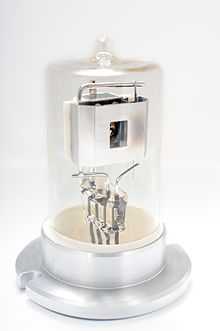Deuterium arc lamp

Principle of operation

A deuterium lamp uses a tungsten filament and anode placed on opposite sides of a nickel box structure designed to produce the best output spectrum. Unlike an incandescent bulb, the filament is not the source of light in deuterium lamps. Instead an arc is created from the filament to the anode, a similar process to arc lamps. Because the filament must be very hot before it can operate, it is heated for approximately twenty seconds before use. Because the discharge process produces its own heat, the heater is turned down after discharge begins. Although firing voltages are 300 to 500 volts, once the arc is created voltages drop to around 100 to 200 volts.[1]
The arc created excites the molecular deuterium contained within the bulb to a higher energy state. The deuterium then emits light as it transitions back to its initial state. This continuous cycle is the origin of the continuous ultraviolet radiation. This process is not the same as the process of decay of atomic excited states (atomic emission), where electrons are excited and then emit radiation. Instead from the molecular emission process, where radiative decay of excited states, in this case of molecular deuterium (D2), causes the effect.
Because the lamp operates at high temperatures, normal glass housings cannot be used for a casing. They would also block UV radiation. Instead, a fused quartz, UV glass, or magnesium fluoride envelope is used depending on the specific function of the lamp.[2]
The typical lifetime of a deuterium lamp is approximately 2000 hours (Most manufacturers guarantee 2000 hours, but newer lamps are consistently performing well out to 5000 hours and more).
Deuterium lamp spectra
The deuterium lamp emits radiation extending from 112 nm to 900 nm, although its continuous spectrum is only from 180 nm to 370 nm. The spectrum intensity does not actually decrease from 250 nm to 300 nm as shown in the spectrum plot above. The decrease in the plot is due to decreased efficiency at low wavelengths of the photo detector used to measure the lamp intensity. Deuterium Lamp's continuous spectrum is useful as both a reference in UV radiometric work and to generate a signal in various photometric devices.
Safety
Due to the high intensity of UV radiation emitted by the bulb, eye protection is suggested when using a deuterium bulb. Care must also be taken to avoid touching the bulb directly to avoid burns due to high operating temperatures. Touching the bulb directly even when cool can smudge the casing and therefore reduce output intensity.
References
- ↑ "Deuterium Lamps". Photron Pty. Ltd. Retrieved 2011-10-20.
- ↑ "Deuterium Lamps". Photron Pty Ltd. 2011-10-20. Retrieved 2011-10-20.
External links
| ||||||||||||||||||||||||||||||||||||||||||||||